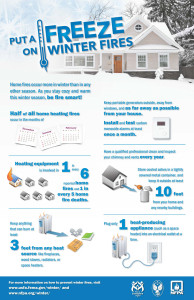The high cost of home heating fuels and utilities have caused many Americans to search for alternate sources of home heating. The use of wood-burning stoves is growing and space heaters are selling rapidly, or coming out of storage. Fireplaces are burning wood and man-made logs.
All these methods of heating may be acceptable. They are, however, a major contributing factor in residential fires. Many of these fires can be prevented. The following fire safety tips can help you maintain a fire safe home this winter.
Wood stoves and fireplaces
Wood stoves and fireplaces are becoming a very common heat source in homes. Careful attention to safety can minimize their fire hazard. To use them safely:
- Be sure the fireplace or stove is installed properly. Wood stoves should have adequate clearance (36”) from combustible surfaces and proper floor support and protection.
- Wood stoves should be of good quality, solid construction and design, and should be laboratory tested.
- Have the chimney inspected annually and cleaned if necessary, especially if it has not been used for some time.
- Do not use flammable liquids to start or accelerate any fire.
- Keep a glass or metal screen in front of the fireplace opening, to prevent embers or sparks from jumping out, unwanted material from going in, and help prevent the possibility of burns to occupants.
- The stove should be burned hot twice a day for 15-30 minutes to reduce the amount of creosote buildup Don’t use excessive amounts of paper to build roaring fires in fireplaces. It is possible to ignite creosote in the chimney by overbuilding the fire.
- Never burn charcoal indoors. Burning charcoal can give off lethal amounts of carbon monoxide.
- Keep flammable materials away from your fireplace mantel. A spark from the fireplace could easily ignite theses materials.
- Before you go to sleep, be sure your fireplace fire is out. NEVER close your damper with hot ashes in the fireplace. A closed damper will help the fire to heat up again and will force toxic carbon monoxide into the house.
- If synthetic logs are used, follow the directions on the package. NEVER break a synthetic log apart to quicken the fire or use more than one log at a time. They often burn unevenly, releasing higher levels of carbon monoxide
Other fire safety tips
- Never discard hot ashes inside or near the home. Place them in a metal container outside and well away from the house.
- Never use a range or an oven as a supplemental heating device. Not only is it a safety hazard, it can be a source of potentially toxic fumes.
- If you use an electric heater, be sure not to overload the circuit. Only use extension cords which have the necessary rating to carry an amp load. TIP: Choose an extension cord the same size or larger than the appliance electrical cord.
- Avoid using electrical space heaters in bathrooms or other areas where they may come in contact with water.
- Frozen water pipes? Never try to thaw them with a blow torch or other open flame, otherwise the pipe could conduct the heat and ignite the wall structure inside the wall space. Use hot water or a laboratory tested device such as a hand held dryer for thawing.
- If windows are used as emergency exits in your home, practice using them in the event fire should strike. Be sure that all the windows open easily. Home escape ladders are recommended.
- If there is a fire hydrant near your home you can assist the fire department by keeping the hydrant clear of snow so in the event it is needed, it can be located.
Finally
- Be sure every level of your home has a working smoke alarm, and be sure to check and clean it on a monthly basis.
- Plan and practice a home escape plan with your family.
- Contact your local fire department for advice if you have a question on home fire safety.

